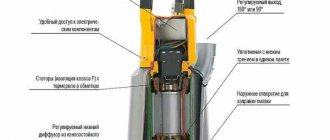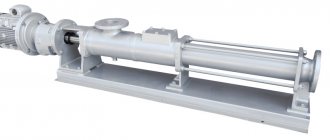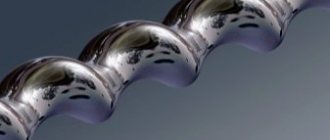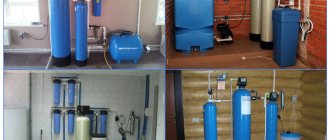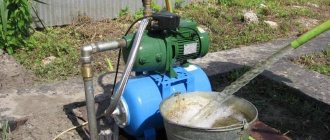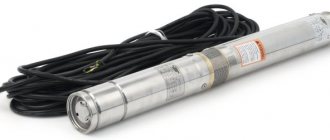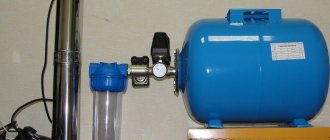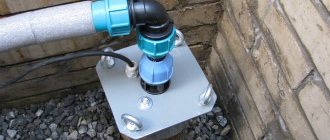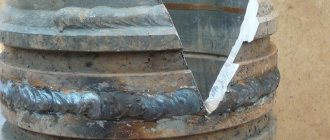Have you decided to install water supply to a private country house, but don’t know which pump to choose for this? Read on for selection criteria
To select the power of the pump and determine its immersion depth, you need to know the flow rate of the water intake source. In this article you will learn what flow rate is, how to calculate it, what factors it depends on, and what to do if the productivity of the water intake structure has decreased.
Definition
Along with diameter and depth, flow rate is the main parameter of any aquifer well. It determines its productivity - that is, the volume of water in cubic meters that can be obtained over a period of time (minute, hour, day). It is logical that the higher this indicator is, the more benefits it will bring in the end. The choice of pumping equipment depends on this characteristic
Why calculate the flow rate yourself?
- In order to accurately verify the volume that you can receive from an autonomous source in a certain time - for example, necessary for watering, or visiting the bathroom.
- For the correct selection of pumping equipment.
Why know the well flow rate?
First of all, it is worth noting that calculating the volume of a well and its flow rate are not the same thing. Volume is a measure of how much liquid the source can hold. And calculating the flow rate of a well or well is an indicator of the volume of liquid received in 1 hour, that is, the productivity of the source. Measured in l/s or m3/h.
It is necessary to know the performance of a structure in order to determine whether the structure is capable of meeting the need for water or whether the flow rate needs to be increased.
The well flow rate is calculated before the drilling company issues a passport for the object, since the characteristics calculated by them may differ from the actual indicator. We tell you how to find out the characteristics of the real water flow in a well.
Characteristics used in calculations
To correctly calculate the flow rate, it is necessary to determine the following well characteristics:
- Static level. Determined by the distance from the soil surface to the water table. It is very easy to calculate - just take a long rope, tie a weight to it and lower it into the water intake shaft. When the weight touches the water, mark the desired location on the rope and measure the resulting length.
- The dynamic level is the same distance, but after water is taken. After the pumping equipment is activated, it pumps out a certain volume of water from the well and stops - while a certain water level remains. The distance to it is measured in a manner similar to the previous one.
Dynamic level is a constantly changing value. Depends on the rate of water flow from the source. The ideal option is the equality of the two levels - this means that the pump pumps out at the same speed as a new portion arrives. Accordingly, if the water remains before the pump has time to pump it out, the well’s flow rate will be higher than its productivity, and vice versa.
Measurements must be taken no earlier than one day after the well is fully equipped. This time is enough for the water level in the water intake shaft to stabilize. If measurements are taken earlier, there will be a high probability that they will not correspond to real parameters.
Calculation of well productivity
The productivity of borehole water intake is an unstable value, depending on many factors and parameters, including the condition and resource of the source, time of year, groundwater movement speed, etc. However, it is possible to approximately calculate the flow characteristics.
When calculating productivity, the following geological characteristics are taken into account:
- static level - the height of the water column at rest (without water intake);
- dynamic level - the height of the water column when the inflow is equal to the outflow (during water intake);
- height of the water column - the distance from the static level to the bottom of the water intake shaft;
- pump performance is a certain volume of liquid that is distilled by a supercharger in a conventional unit of time.
To determine these indicators you will need the following inventory:
- submersible pump;
- cord or thick fishing line with weight and float;
- measuring container;
- tape measure and stopwatch.
Attention! To ensure accurate results, do not use the well for 3-4 hours before starting measurements.
Sequence of actions on how to find out the productivity of a water well:
- Determine the depth of the source from the edge of the tip to the top point of the filter layer. If the depth of the water intake shaft is unknown, lower a cord with a weight at the end into it until it reaches the sandy bottom. Then pull out the cord and measure its length. From the resulting number, subtract from 2 to 4 meters for the filter itself and the sump.
- Calculate the static level. Performed with the pump turned off! Hang the weight and float on the fishing line. Lower the meter into the well until the line sags, which means the float has touched the water. Pull out the fishing line and measure how much of it went into the well.
- Calculate dynamic level. To do this, while pumping out the water, lower the fishing line with an attached weight and float into the head until the fishing line weakens. Then pull out the line and measure the distance from the point where the line weakened to the float.
- Determine the dynamic level using a vibration pump. Slowly pull the device out of the shaft and listen when it starts to work in critical mode (dry). At this moment, put a mark on the hose and pull out the pump completely. Measure the distance from the mark to the device. This will give you the distance to the water surface.
- Calculate the pump performance. Lower the blower into the well and leave it running for one hour. Then fill the measuring container with the pump, while measuring the time using a stopwatch. For example, a 5 liter bucket is filled in 20 seconds. Accordingly, in a minute 15 liters will be collected, and in an hour the maximum production will be 900 liters = 0.9 m³.
After the volume of liquid pumped by the pump has been calculated, the productivity of the aquifer source is then calculated using formulas.
How to calculate?
To calculate the flow rate, a simple formula is used, which is used by most well owners:
D=V*Hв/(Hdin – Hstat)
Here V is the pump performance (how many cubic meters are pumped out per hour), Hв is the height of the water column (the difference between the depth of the well and the statistical water level), Hdin is a dynamic indicator, Hstat is a statistical indicator.
This method will allow you to find out only the approximate value of the well's flow rate, since there is no direct relationship between the performance of pumping equipment and changes in levels. Simply put, if you take another pump and carry out the same calculations, the result may turn out to be completely different. For more accurate calculations, the Dupuis formula is used.
You can find out the performance of the pump from the technical data sheet, or from the meter of the volume of water consumed.
Debit calculation
The simplest way to calculate the flow rate of a well is as follows:
Дт = (О/(Уд – Ус)) x Ув
Dt – well flow rate
О – volume of water intake or pump performance
UD – level in dynamics
Ус – level in statics
Hv – height of the water column
For example, if the depth of the well reaches 100 m, the static level is 50, and the dynamic level is 60, with a pump capacity of 5 m³/hour, then, based on the formula, it turns out:
(5/(60 – 50)) x 50 = 25 m³/hour
Specific flow rate
It would also be useful to know that the specific flow rate of a well is the volume of pumped water that the source will produce when the water table level drops by every meter. Calculated using the following formula:
D beat = (O2-O1)/(U2-U1)
Dsp – specific flow rate
O2 – volume of water at the second intake
O1 – similar indicator for the first water intake
U2 – decrease in level upon repeated intake
U1 – decrease in level during the first intake
For example, it was determined above that if when pumping water with a pump with a power of 5 m³/hour, the level drop was 10 meters, then increasing the motor power to 10 m³/hour, the drop increased to 20 m. Thus, substituting the values into the formula we get:
D beat = (10-5)/(20-10) = 0.5 m³/hour
Measuring water level in a well Source kabel-house.ru
Specific value
To accurately determine the flow rate, the above measurements must be carried out at least twice, preferably with different pumps. Of course, in this case one cannot guarantee one hundred percent accuracy, but the result obtained will be more accurate.
After a day, after the previous water intake, when the water column stabilizes and is equal to the calculated static value, pump it out with another pump and measure the dynamic level. Then we substitute the obtained data into the following formula:
Dsp = (V2 – V1)/(H2 – H1)
Here, V2 and V1 are the difference in the performance of the two pumps, and H2 – H1 is the difference between the static and dynamic levels at the first and second intake. Thus, we obtain the specific flow rate of water intake - an indicator by which the real or average flow rate is exceeded as the dynamic level increases.
Flow definitions
After drilling, the organization that carried out the work provides a test report, or a passport for the well, in which all the necessary parameters are entered. However, when drilling for households, contractors often enter approximate values into the passport.
You can double-check the accuracy of the information or calculate the flow rate of your well yourself.
However, it is difficult to accurately calculate the productivity of a source. Calculating indicators requires time and special equipment. But the result obtained will be enough to understand the capabilities of your source.
Dynamics, statics and height of the water column
Before you start taking measurements, you need to understand what the static and dynamic water level in a well is, as well as the height of the water column in the well column. Measuring these parameters is necessary not only to calculate the productivity of the well, but also to correctly select the pumping unit for the water supply system.
- The static level is the height of the water column in the absence of water intake. Depends on in-situ pressure and is set during downtime (usually at least an hour);
- Dynamic level - the steady water level during water intake, that is, when the influx of liquid is equal to the outflow;
- Column height is the difference between the well depth and the static level.
Dynamics and statics are measured in meters from the ground, and the height of the column from the bottom of the well
You can take a measurement using:
- Electric level gauge;
- An electrode that makes contact when interacting with water;
- An ordinary weight tied to a rope.
Measurement using a signaling electrode
Determining pump performance
When calculating the flow rate, it is necessary to know the pump performance during pumping. To do this, you can use the following methods:
- View flow meter or meter data;
- Read the passport for the pump and find out the performance by operating point;
- Calculate the approximate flow rate based on water pressure.
In the latter case, it is necessary to fix a pipe of smaller diameter in a horizontal position at the outlet of the water-lifting pipe. And make the following measurements:
- Pipe length (min. 1.5 m) and its diameter;
- Height from the ground to the center of the pipe;
- The length of the jet from the end of the pipe to the point of impact on the ground.
After receiving the data, you need to compare them using a diagram.
Compare the data by analogy with the example
Measuring the dynamic level and flow rate of the well must be done with a pump with a capacity not less than your calculated peak water flow.
Simplified calculation
Well flow rate is the ratio of the product of water pumping intensity and the height of the water column to the difference between dynamic and static water levels. To determine the flow rate of a well, the following formula is used:
Dt =(V/(Hdin-Nst))*Hv , where
- Dt – required flow rate;
- V – volume of pumped liquid;
- Hdin – dynamic level;
- Hst – static level;
- Hv – height of the water column.
For example, we have a well 60 meters deep; the statics of which is 40 meters; the dynamic level when operating a pump with a capacity of 3 cubic meters per hour was established at around 47 meters.
In total, the flow rate will be: Dt = (3/(47-40))*20= 8.57 cubic meters/hour.
A simplified measurement method involves measuring the dynamic level when the pump is operating at one capacity; for the private sector this may be sufficient, but not to determine the exact picture.
Specific flow rate
With an increase in pump performance, the dynamic level, and, accordingly, the actual flow rate decreases. Therefore, water intake is more accurately characterized by the productivity coefficient and specific flow rate.
To calculate the latter, not one, but two measurements of the dynamic level should be made at different water intake rates.
The specific flow rate of a well is the volume of water released when its level decreases for each meter.
The formula defines it as the ratio of the difference between the larger and smaller values of water intake intensity to the difference between the values of the drop in the water column.
Dsp=(V2-V1)/(h2-h1), where
- Dsp – specific flow rate
- V2 – volume of pumped water during the second water intake
- V1 – primary pumped volume
- h2 – decrease in water level at the second water intake
- h1 – level reduction at the first water intake
Returning to our conditional well: with water intake at an intensity of 3 cubic meters per hour, the difference between dynamics and statics was 7 m; when re-measuring with a pump capacity of 6 cubic meters per hour, the difference was 15 m.
In total, the specific flow rate will be: Dsp = (6-3)/(15-7)= 0.375 cubic meters/hour
Real flow rate
The calculation is based on the specific indicator and the distance from the ground surface to the top point of the filter zone, taking into account the condition that the pumping unit will not be submerged below. This calculation is as close to reality as possible.
D t = (H f - H st ) * D beat, where
- Dt – well flow rate;
- Hf – distance to the beginning of the filtration zone (in our case we will take it as 57 m);
- Hst – static level;
- Dsp – specific flow rate.
In total, the real flow rate will be: Dt = (57-40)*0.375= 6.375 cubic meters/hour.
As you can see, in the case of our imaginary well, the difference between the simplified and subsequent measurements was almost 2.2 cubic meters per hour in the direction of decreasing productivity.
average value
After determining the specific indicator, we reach the finish line and can calculate the average flow rate - the actual value of the well's productivity. It is calculated as follows:
D = (Hph – Hstat)* Dsp
Hf is the level at which the pump filter is located, Hstat is the statistical water level, Dsp is the specific flow rate.
Depending on the obtained value, three types of water wells can be distinguished:
- Low productivity (daily flow rate - no more than 20 m3);
- Medium (from 20 m3);
- High (from 85 m3).
What it is?
When answering the question about what a well’s flow rate is, we mean the volume of liquid that we can obtain in a specified period of time.
When talking about volume, they mean the number of cubic meters of water that will be pumped out in 1 hour. This fact depends on many criteria, including the choice of equipment.
Understanding the drilling procedure, we immediately consider such a concept as the diameter of the well. At the same time, depending on the choice of drilling location, the production rate of wells with two identical diameters may be different. As we said earlier, it depends on the choice of equipment and is determined by the amount of water masses that will fill the well over a period of time.
In some cases, about 4 cubic meters of water can be pumped out in 1 hour, which characterizes the well as a source with a small flow rate. Sometimes, with an equal diameter, up to 300 cubic meters can be pumped out.
It is quite difficult to determine in advance what your well will be like. Basically, if the organization has drilled in your area more than once, then the company’s representatives know to what depth they need to drill so that there is enough water for your needs. Otherwise, the amount of water is determined by using a powerful pump, or using an airlift.
How to choose pumping equipment?
Now it remains to determine what pump performance will be most optimal for you. It is not difficult to calculate this parameter - you need to count the number of all water points in the building, and then multiply the resulting number by the volume of water that one point produces per hour.
Don’t bother running for containers - this value is 0.5 m3. As a result, we get the pump performance we need.
It is necessary to carry out such measurements several times a year in order to make sure that water continues to flow into the well in the required quantities. To do this, you only need a measuring cup, a tap and a stopwatch. The time it takes to fill the dishes is measured - if at the next measurement the time matches, then there is nothing to fear, and the source is working at full capacity.
How to determine?
You can calculate it in two simple ways:
- Submerge a high-performance pump into the source. Turn it on and completely pump out the water. Your task is to determine its real quantity. It is better to use a large container as a measure. You can also look at the technical characteristics of the pump according to the passport. You will be interested in how much water the pump can pump in a certain unit of time. So, you need to time the start and end of pumping. This level will be called static. You need to divide the amount of total fluid pumped by the time spent. So you get the volume of the source.
- This method involves immersing the pump to the very bottom. In this case, the pump must have a performance that will meet the needs of a private home. During the pumping process, you should monitor the degree of liquid fall. It is necessary to wait for the moment when it stabilizes, that is, has time to recover and remain at the same level. This indicator is called dynamic.
Reasons for the decline
If, when taking measurements, it turns out that it is taking longer to fill a vessel of the same volume, you should think about it. Most likely, the reason for the decrease in flow rate lies in:
- malfunction of pumping equipment;
- c contamination of the filtration system;
- siltation of the wellbore.
In this case, it is enough to seek help from specialists who will clean the pump filter and, if necessary, replace worn or failed elements.
If these measures do not help, the reason lies in the well itself - or rather, in its improper arrangement, the use of low-quality or unsuitable materials, low-quality filters, etc. In this case, the best solution would be to submit an application to the company that carried out the drilling, or contact another similar organization, since it will not be possible to correct the situation on our own.
Qualified specialists will drain the well for a while, after which they will carry out the necessary diagnostic work and replace faulty elements. These measures are sufficient to correct the vast majority of possible malfunctions in the operation of water-bearing wells.
In addition, the flow rate may decrease due to changes in climate - for example, due to severe drought and lack of precipitation. These changes are temporary and do not have any impact on the well or pumping equipment, so you can only be patient and wait for the weather to change.
Decrease in flow rate
During operation, the well's productivity may decrease; the main reason for the decrease in flow rate is clogging, and to increase it to the previous level, it is necessary to clean the filters.
Over time, the impellers of a centrifugal pump can wear out, especially if your well is in sand, in which case its performance will decrease.
However, cleaning may not help if you initially have a low-yield water well. The reasons for this are different: the diameter of the production pipe is insufficient, it fell past the aquifer, or it contains little moisture.
Magnification methods
The question most owners ask is how to increase the flow rate of a water well? The answer is simple - practically nothing. A slight change in a positive direction is possible only at the very beginning, when drilling is completed.
By connecting the pump to the well, it is possible to extract a certain amount of foreign inclusions from it, which will increase its overall productivity by 2-3 m3 per hour. However, such measures do not always help.
If the well is used for a long time, no additional reserves for increasing the flow rate will be possible. The only thing that can be done in such a situation is to purchase a hydraulic accumulator of the required volume and connect all or some water points to it. This solution will provide you with the necessary volume of water at relatively low costs.
How does the pump's immersion depth affect performance?
Submersible pumps, in accordance with the instructions, must be placed as far as possible from the well filter. At the same time, the normal distance to the static water level should be at least 1 meter.
Attention! The optimal depth of the pump is the point of the most intense water influx.
At the same time, when choosing at what depth to install the pumping station, it should be taken into account that the productivity of the water intake source decreases in proportion to the distance from the bottom. That is, at a depth of 40 meters, where the filter is located in the shaft, the liquid output will be maximum and, according to calculations, will be 3.6 m³/hour.
Whereas at a depth of 28 meters the output will be 1.8 m³/hour, and at a depth equal to the static level the flow rate will be very small. To ensure optimal performance of the domestic water supply, the pump must be located at a depth of 28 to 35 m.
Is recovery possible?
Over time, the wellbore filter can become overgrown with silt particles and become clogged with sand and organic deposits. These natural processes directly affect the reduction in water intake productivity. Restoring debit in this case is possible in two ways:
- Vibration effect. To do this, a special device is used, which is lowered into the water on a cable to the depth of the filter. When it vibrates, accumulations of sand, silt, limestone and other contaminants peel off from the filter.
- Chemical exposure. To do this, the filter is filled with acid, after which all contaminants are dissolved.
In conclusion, it is worth noting once again that carrying out all the above calculations will allow the use of water-bearing equipment efficiently and safely. Accurate calculations will not only provide the required volume of water in free access, but also significantly save on the purchase of related equipment.
How to revive a well
This is how an artesian well is repaired
It is possible to restore low-yield wells or those that were in working condition, and then forgotten about them, and they were not used for a long period. They can be classified as abandoned structures.
Quite often, such a fate awaits sand wells with shallow depths: water drains out of them, and they silt up. Various methods of well reanimation involve analysis of initial data.
So:
- The design of the well itself and the filter is considered.
- The colmatation process and its stages are determined by the decrease in permeability as a result of the penetration of solid particles into the pore space, as well as the formation of a filter cake when clogging the rock accessible for penetration, the intensity of their manifestations.
- Changes in the chemical and physical state of these deposits.
- The surrounding aquifers, rocks and their filtration characteristics are determined.
- Restoring the well flow rate closest to the original data is ensured by selecting the most optimal method that will help obtain the desired result.
Stages of structural restoration
So:
- Conducting video diagnostics and research. The pipe is examined in detail to detect problems and malfunctions. A rough work plan is drawn up.
- Next comes the cleaning of debris and dust that has accumulated in it during the period of inactivity.
Attention: The main part of the work involves removing silt from the receiving water.
- Sludge can be purified using pressurized water.
- Treatment with special reagents.
- Water hammer.
- Compression-depression is one of the methods used to increase the productivity of deep wells.
- New technologies have made it possible to obtain a very effective and at the same time economical complex design for restoration today.
- At the same time, a high-pressure hydrodynamic installation and a cavitation hydrodynamic vibrator are used, causing the pressure in the liquid to fluctuate.
- Any, even the most hopeless well, after using this method of reviving the structure, can be operated again.
- This technology, used in combination, allows you to clean the sump, pipes, increase the flow rate and carry out other actions in order to obtain high-quality well operation and ensure water supply.
- The advantage of the method is the effect on the productive, aquifer layer and the destruction of the layer of any contaminants in the pipe. Vibration creates vibrations of water under high pressure and destroys accumulations of sand, limestone and other sedimentary rocks and elements.
The advantage of restoration work
Transparent water cannot leave anyone indifferent
The video we watched in this article and in other materials allows us to note the positive aspects of the restoration work:
- The throughput flow of the structure is resumed with indicators not lower than the initial data, at a minimum.
- The flow rate can be maintained for 5-6 years, so there is no need for frequent repetitions of preventive maintenance.
- The short-term pulse method of exposure does not harm ceramic, wire and other types of filters.
- The instructions instruct you to pay attention to any damage that may seem insignificant at first glance, which can greatly reduce the efficiency of the water well and the regularity of its use.
- The instrument complex is distinguished by the mobility of procedures due to its own containers for working reagents and a separate drive.
- There are no rubbing parts in the cavitation vibrator, so we can talk about the high technical reliability of the complex, which is also ensured by its manufacturing from materials with high strength.
- Restoring a well with your own hands is almost impossible, so you will have to turn to professionals.
- I would immediately like to know what the cost of restoration work is in order to determine financial possibilities.
- The exact cost figure is determined only after the craftsmen are able to assess the complexity of the upcoming work.
- The photo shows that wells contain not only water, but also oil and gas. It is important that they have similar problems. Low flow rates are present not only near water. How low-yield gas wells are operated will help you understand the technologies for drilling and restoring wells.
- Restoring inactive structures and increasing the productivity of low-yield structures is carried out by drilling sidetracks. This method comes out on top among similar methods.
- It is of particular relevance for Western Siberia, where the late stage of development of oil and gas deposits begins. It is characterized by noticeable watering of objects in operation.
How to increase flow?
If previously the volume was normal, but gradually began to decrease and now it is necessary to increase it. There are several technologies. To begin with, it is worth carrying out simpler actions, for example, cleaning the casing. It may be worth expanding it from various deposits.
Important! When cleaning the shaft, the pump must be raised to the surface.
Plus, a clogged filter can affect the decrease in fluid supply, so it’s also worth cleaning it. And in some cases, the pump is the culprit. You can find out if the dynamic level has dropped and there is no desired performance.
Among other things, the flow rate can increase if you use the following technologies:
- Swabbing.
- Pneumopulsation.
- Electrohydraulic shocks.
- Vibration.
- Pulsing.
- Washing the filter.
